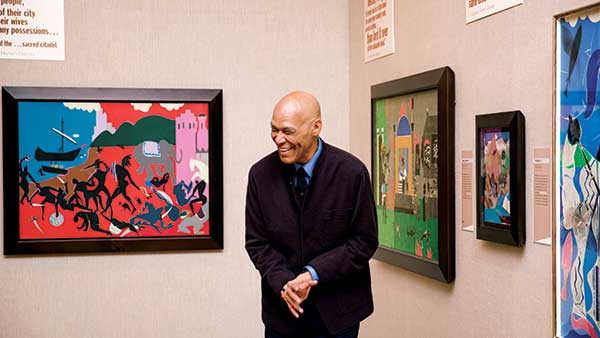Romare Bearden: A Black Odyssey

Romare Bearden is widely recognized as one of the most original and significant artists of the 20th century. Bearden (1911-1988) moved to New York City from Charlotte, North Carolina, and—notwithstanding occasional sojourns to Europe and the Caribbean—remained here for most of his life; indeed he worked for several years in a studio above the Apollo Theater, not far from the Morningside and Manhattanville campuses. His art features a broad variety of American scenes—northern and southern, urban and rural, contemporary and historical—but he is perhaps best known for his richly textured collages, depictions of universal stories featuring African American subjects.
In 2014-2015, Columbia University hosted a major Smithsonian Institution traveling exhibition of Bearden’s work and an accompanying series of lectures, readings, performances, and other events celebrating the artist. On display at the Miriam and Ira D. Wallach Gallery on the Morningside campus, and also at Columbia’s Global Centers in Paris and Istanbul, “Romare Bearden: A Black Odyssey” focused on cycle of collages and watercolors Bearden completed in 1977 based on Homer’s epic poem, The Odyssey—the story of Odysseus’s ten-year journey home to Ithaca after the fall of Troy. A tour of the Wallach Gallery exhibition by Robert O’Meally, Columbia’s Zora Neale Hurston Professor of English and Comparative Literature and director of the University’s Center for Jazz Studies, and Deidra Harris-Kelley, Executive Director of the Romare Bearden Foundation, is online, linked below.
Columbia University is now preparing a digital exhibition, an online media repository, and new films and video—including video of the 2014-2015 events and over 100 speakers and performers—to celebrate Bearden and his works. The Center for Teaching and Learning (CTL), under its Associate Director Peter B. Kaufman, is producing the audiovisual media for the initiative, some samples of which are now available here:
Bearden expert Robert O’Meally has written that Bearden’s interpretations of the Odyssey bridge classical mythology and African-American culture, moving us with universal human tales—a son longing for a missing father; a wife dealing with men who try to take her husband’s place; a traveling man resisting the wiles of goddesses and witches; greed; hunger; the search for home. The Odyssey series shines a light as well on a journey of another sort—the Great Migration of blacks from the South to the North—and it layered in, from multiple angles, stories of the black experience in America in the 1970s.
O’Meally explains that in 1977, Bearden saw Harlem in Homer’s Odyssey—and Odysseus in Harlem. To stress the universality of the Greek epic, Bearden makes all of his Homeric figures black: gods, mortals, heroes, and villains all. His “Poseidon,” Odysseus’s scowling nemesis, is a powerhouse African masked god. Bearden collaborates with Homer, rather than just illustrating Homer’s words—Bearden and Homer, as two artists, “play together like section-mates in a jazz-band.” The contemporary significance of the story is everywhere. “The Fall of Troy” in the series, alight with flames and weapons, parallels the riots and rebellions in American cities as blacks protested for equal citizenship in a country still resolving issues from its own Civil War. And the Harlem aspect was no accident. Bearden counted among his friends such distinguished artists, intellectuals, and musicians as James Baldwin, Langston Hughes, Ralph Ellison, Duke Ellington, Alvin Ailey, Jacob Lawrence, and Albert Murray. A powerful writer and spokesman on the issues of the day, he became the first art director of the Harlem Cultural Council and helped to found several important art venues, including the Studio Museum in Harlem.
Hundreds of hours of video of Bearden are slated to become part of a new Bearden digital repository, and material from the repository will be used to teach subject and themes across disciplines ranging from art, literature, and music to history, politics, and science—with a special focus on Homer, the classics, and the core curriculum. The resulting video will be exhibited worldwide in class, online, and in film and television—promoting an appreciation of Bearden and his achievements for years to come.
The artwork’s appearance at Columbia was organized in part by the Smithsonian Institution Traveling Exhibition Service in cooperation with the Romare Bearden Foundation and Estate and the DC Moore Gallery, with generous support from Columbia’s Office of the President and the Stavros Niarchos Foundation.
—
For important resources on Bearden, see O’Meally’s book, Romare Bearden: A Black Odyssey, featured on the Smithsonian Institution’s website for the traveling exhibition. See also the resources available at the Romare Bearden Foundation.